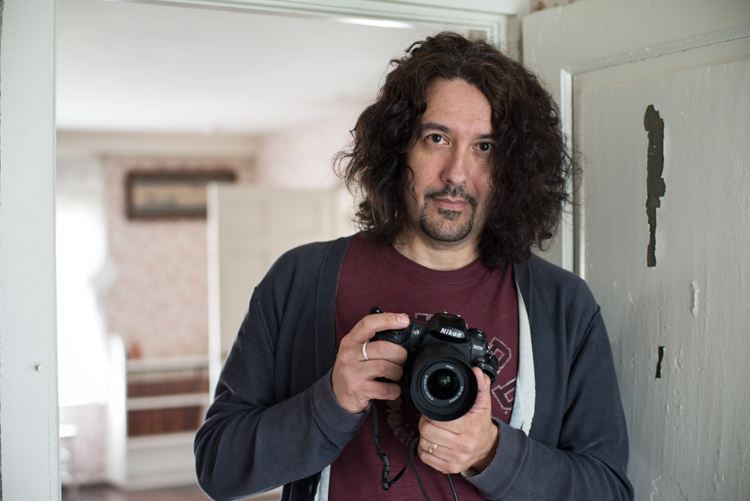In his first two exhibits, Roslyn Heights photographer Xiomaro captured the historic essence of the unfurnished estates of expressionist painter Julian Alden Weir and President Theodore Roosevelt while they were under renovation.
In his latest exhibit, “William Floyd’s House of Revolution,” Xiomaro [pronounced See-oh-mar-oh] takes on the Mastic Beach home of the famous American revolutionary who served the first Continental Congress in 1774 and signed the Declaration of Independence.
The exhibit, which opened July 4 at the Fraunces Tavern Museum in Manhattan and runs through Dec. 1, features 17 photos that Xiomaro says define William Floyd and the eight generations of his family who called the 25-room “Old Mastic House” their home.
“The thing with Floyd is he lived there so long ago that there’s just not that much stuff on him,” said Xiomaro, whose real name is Richard Dieguez.
Floyd was born on the estate in 1734 and became a significant Long Island figure in the period leading up to the American Revolution, but he fled to Connecticut in 1774 as British occupation spread throughout the area.
In his exile, Floyd’s 613-acre estate became a barracks for British soldiers, who destroyed many of the belongings he left behind.
“Not much survived the war,” Xiomaro said. “Most of it was ransacked and damaged by the British.”
Floyd rebuilt the property following his return seven years later, but his descendants continued to modify the property until the estate was donated to the National Park Service in 1977.
“I was thinking of an exhibit that teased out him and the revolution, but as I got through the project I realized there wasn’t all that much and I wouldn’t be able to get the most out of that narrative,” Xiomaro said.
Showcased in the exhibit are photos of Floyd’s surviving possessions, which include a snuffbox, a Chippendale Secretary desk unit and what is known as a “traveling medicine chest” in which Floyd carried his liquor.
But that’s only half of what Xiomaro wanted to accomplish through the exhibit, he said, as the rest of the photos chronicle the changes the house has undergone over the years.
“It soon occurred to me that there were these incredible juxtapositions as you move through the house,” Xiomaro said. “There’d be this huge kitchen with a fireplace and huge hearth, and then you’d go upstairs and see this kitchen that’s right out of ‘Leave It To Beaver.’”
Xiomaro added, “Those kinds of things, when they’re right next to each other, are really interesting. You don’t really see those all the time and it really shows the change between how things were and how they are today.
Xiomaro has lived in Roslyn Heights since 1988 and was previously an entertainment lawyer representing musicians and actors, but after beating prostate cancer in 2005 he began singing and painting under his pseudonym, which is Spanish for “Ready for Battle.”
Xiomaro traveled the country, singing in coffee shops and photographing national parks he’d visit along the way, and in 2011 he was commissioned by the Julian Alden Weir estate’s Artist-in-Residence program to photograph the unfurnished rooms of the Connecticut landmark as it underwent renovation.
The work was showcased at Weir Farm and throughout Connecticut and eventually caught the eye of administrators at Theodore Roosevelt’s Sagamore Hill estate who had begun planning a similar renovation project and arranged for him to photograph the bare interiors of the former President’s home.
The 20-photo exhibit, titled “Theodore Roosevelt: How I Love Sagamore Hill” ran from Feb. 14-June 2 at the Koenig Center in Oyster Bay and will be on display at Harvard University through next year.
Xiomaro began photographing the Floyd estate in April but said he didn’t get out to the house as often as he would have liked because its funding had declined due to the national sequester.
“It got closer to June and realized I had to zero in on certain images I wanted to capture so I knew I’d have something for the exhibit that brought out the themes I wanted to show through the photos,” Xiomaro said.
Xiomaro said he plans to continue visiting and photographing the Floyd estate and updating the exhibit periodically, as the property was so large he hadn’t gone through its entirety before the exhibit opened.
“It’s really different from the Roosevelt house and the Weir house, but I think that’s part of the charm,” Xiomaro said. “There’s so many rooms, it’s easy to get lost. You ask yourself, ‘Where am I?’ and find that you don’t even know where you are anymore.”
Xiomaro said another major difference for this project was the fact that the rooms in the Floyd estate were furnished, which presented more details to capture with his camera and more risk to keep the house and its contents intact.
“It’s a slower process because there are many things in my way and I have to be more deliberate and careful with what I do,” Xiomaro said. “When the house is empty, there’s more space, but when there’s more furnishings, one wrong move of a tripod and something’s coming down.”
Xiomaro said he is currently looking for other sites to display the Floyd photos that have similar revolutionary roots to the Fraunces Tavern and Museum, where then-General George Washington bid farewell to his men after the war ended in 1783, and that Boston and Philadelphia are possible cities.



